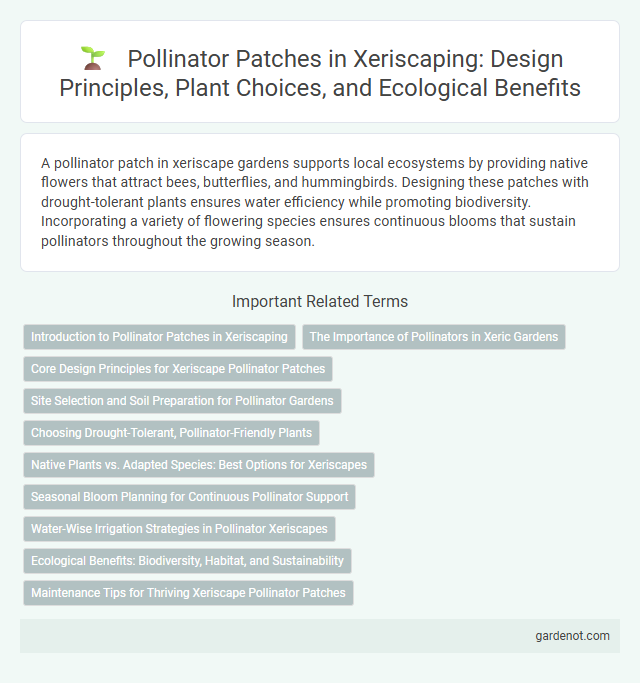A pollinator patch in xeriscape gardens supports local ecosystems by providing native flowers that attract bees, butterflies, and hummingbirds. Designing these patches with drought-tolerant plants ensures water efficiency while promoting biodiversity. Incorporating a variety of flowering species ensures continuous blooms that sustain pollinators throughout the growing season.
Introduction to Pollinator Patches in Xeriscaping
Pollinator patches in xeriscaping consist of drought-tolerant plants that attract bees, butterflies, and other essential pollinators, enhancing biodiversity while conserving water. These patches utilize native species like blanket flower, coneflower, and salvia, which thrive with minimal irrigation, supporting ecosystem health in arid environments. Integrating pollinator patches into xeriscapes improves soil quality and assists in the pollination of nearby crops, benefiting both wildlife and agricultural productivity.
The Importance of Pollinators in Xeric Gardens
Pollinator patches in xeriscape gardens play a vital role in supporting biodiversity and enhancing plant reproduction by attracting essential pollinators such as bees, butterflies, and hummingbirds. These pollinators contribute to the successful seed production of drought-tolerant native plants, ensuring ecosystem resilience in water-scarce environments. Maintaining a diverse pollinator patch improves soil health and encourages a balanced habitat, promoting sustainability in xeric landscapes.
Core Design Principles for Xeriscape Pollinator Patches
Xeriscape pollinator patches prioritize water-efficient native plants that provide continuous blooms to support diverse pollinators year-round. Strategic plant placement maximizes sunlight exposure and wind protection, enhancing pollinator visitation and habitat quality. Soil health is maintained through mulching and minimal disturbance, promoting sustainable moisture retention and root growth.
Site Selection and Soil Preparation for Pollinator Gardens
Choosing a sunny location with well-drained soil is crucial for establishing a successful pollinator patch in xeriscape landscapes. Soil preparation involves removing debris and loosening the soil to promote root penetration and adequate water infiltration. Incorporating organic matter enhances soil fertility and moisture retention, supporting diverse native flowering plants essential for attracting pollinators.
Choosing Drought-Tolerant, Pollinator-Friendly Plants
Selecting drought-tolerant, pollinator-friendly plants for a xeriscape pollinator patch enhances ecosystem resilience while conserving water. Native species such as purple coneflower, black-eyed Susan, and desert milkweed provide essential nectar and habitat for bees, butterflies, and hummingbirds. Incorporating a variety of flowering plants with staggered bloom times ensures continuous support for pollinators throughout the growing season.
Native Plants vs. Adapted Species: Best Options for Xeriscapes
Native plants such as coneflowers (Echinacea) and milkweed (Asclepias) provide essential nectar and habitat for local pollinators, ensuring ecosystem balance and drought tolerance in xeriscapes. Adapted species like lavender (Lavandula) and Russian sage (Perovskia atriplicifolia) offer additional drought resistance and continuous bloom periods, enhancing both aesthetics and pollinator support. Prioritizing native plants promotes biodiversity and soil health, while carefully selected adapted species contribute resilience and extended flowering seasons within water-efficient landscapes.
Seasonal Bloom Planning for Continuous Pollinator Support
Seasonal bloom planning in a pollinator patch ensures continuous nectar sources by strategically selecting native wildflowers and shrubs with staggered flowering periods from early spring through late fall. Incorporating a diversity of blooms such as purple coneflower, milkweed, and bee balm provides essential habitat and sustenance for bees, butterflies, and hummingbirds. Proper timing enhances pollinator health and biodiversity, contributing to a resilient xeriscape garden.
Water-Wise Irrigation Strategies in Pollinator Xeriscapes
Pollinator xeriscapes benefit from water-wise irrigation strategies such as drip irrigation and timed watering schedules that minimize water use while ensuring plant hydration. Selecting drought-tolerant, native flowering plants supports pollinators by providing consistent nectar sources without excessive irrigation. Efficient water management practices in pollinator patches enhance sustainability and promote healthy ecosystems by conserving resources and maintaining optimal soil moisture levels.
Ecological Benefits: Biodiversity, Habitat, and Sustainability
A xeriscape pollinator patch enhances biodiversity by supporting native plant species that attract bees, butterflies, and other essential pollinators. These patches provide critical habitat and foraging resources, contributing to the stability of local ecosystems and promoting sustainable urban landscapes. By conserving water and reducing chemical use, pollinator patches ensure long-term ecological balance and resilience.
Maintenance Tips for Thriving Xeriscape Pollinator Patches
Regularly remove invasive weeds and dead plant material to promote healthy growth and prevent competition in xeriscape pollinator patches. Water deeply but infrequently to encourage deep root development and drought resilience among native plants. Prune flowering plants after blooming to stimulate new growth and extend the pollination season while supporting local pollinator populations.
Pollinator patch Infographic

 gardenot.com
gardenot.com